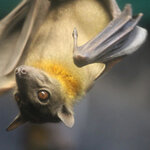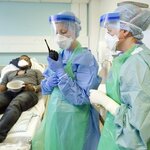Immunology

Credit: Diana Ranslam, CC BY-NC
By Alexandra Kamins, Colorado Hospital Association; Marcus Rowcliffe, Zoological Society of London, and Olivier Restif, University of Cambridge
In an era flush with vaccines and antibiotics, when the greatest health risks in the developed world ride on the back of fried fish and hamburgers, it is easy to forget that infectious diseases still account for a quarter of all human deaths worldwide.
Although this is a burden largely carried by more impoverished nations, the unfolding Ebola outbreak is a dramatic reminder that infectious diseases, and the dangers they…

Conventional medical centers may be unable to prevent spread of Ebola, writing a group of infectious disease experts
in the Annals of Internal Medicine.
The authors suggest that conventional U.S. medical centers are unprepared and ill equipped to manage Ebola and a national network of specialized containment and treatment facilities may be needed to reduce the virus' spread.
Despite efforts from the Centers for Disease Control and Prevention (CDC) to prepare hospitals for Ebola, enormous challenges remain. The authors express doubt that conventional settings can adequately prepare and…

Lab scientists working with Ebola use respirators, while surgical masks are deemed adequate for nurses at the front line. Credit: EPA/Anne-Marie Sanderson/DOH
By C Raina MacIntyre
American nurse Nina Pham is the second health worker to contract Ebola outside of West Africa while caring for patients with the virus, despite using personal protective equipment. Authorities were quick to attribute lapses in protocol for Pham’s and Madrid nurse Teresa Romero Ramos' infection. But inadequate guidelines for personal protective equipment (PPE) may equally be to blame.
The World Health…

Females are naturally more resistant to respiratory infections than males
and now researchers have linked that increased resistance to bacterial pneumonia in female mice to an enzyme called enzyme nitric oxide synthase 3 (NOS3), which is activated by the female sex hormone estrogen.
The team, lead by Professor Lester Kobzik at the Harvard University School of Public Health, introduced Streptococcus pneumoniae into the lungs of mice to mimic the inhalation of bacteria that occurs naturally as we breathe.
Female mice and male mice that had been treated with estrogen were able to clear…

Credit: Institute of Responsible Technology
By Jon Entine, Genetic Literacy Project
It’s perplexing that strident anti-GMO critics who regularly harp on the “danger” of harvesting a “foreign” gene from one species and inserting into another to improve crop performance or nutrition are mostly silent when the exact same process is used to engineer new drugs. The Ebola crisis and the desperate search for viable treatments highlights that oddity.
GM opponents say such a process ‘violates’ Nature–citing a handful of studies (discredited or fabricated) that suggest that humans…

Elephants are among the most intelligent non-humans, arguably on par with chimpanzees, and both African and Asian elephants are endangered.
In 1995, 16-month old Kumari, the first Asian elephant born at the National Zoo in Washington, DC, died of a mysterious illness. In 1999, Gary Hayward of Johns Hopkins University and collaborators published their results identifying a novel herpesvirus, EEHV1 as the cause of Kumari's sudden death. They now show that severe cases like this one are caused by viruses that normally infect the species, rather than by viruses that have jumped from African…

Though numerous experts and policy makers have called for hospitals to screen patients for methicillin-resistant Staphylococcus aureus (MRSA) infections and isolate anyone testing positive to prevent the spread "Superbugs" in healthcare settings, it's too economically burdensome. Several states have enacted laws requiring patients be screened for MRSA upon admission but two new abstracts, scheduled for presentation on Friday at IDWeek, the annual scientific meeting for infectious disease specialists, found universal MRSA screening and isolation of high-risk patients will help…

Researchers have created a molecule known as a peptide mimic that displays a functionally critical region of the virus that is universally conserved in all known species of Ebola. This new tool can be used as a drug target in the discovery of anti-Ebola agents that are effective against all known strains and likely future strains.
Ebola is a lethal virus that causes severe hemorrhagic fever with a 50 percent to 90 percent mortality rate. There are five known species of the virus. Outbreaks have been occurring with increasing frequency in recent years, and an unprecedented and…

It's an early lesson in genetics: we get half our DNA from Mom, half from Dad.
But that straightforward explanation does not account for a process that sometimes occurs when cells divide. Called gene conversion, the copy of a gene from Mom can replace the one from Dad, or vice versa, making the two copies identical.
In a new study, researchers investigated this process in the context of the evolution of human populations. They found that a bias toward certain types of DNA sequences during gene conversion may be an important factor in why certain heritable diseases persist in populations…

Though it has been researched for decades, the cause of nodding syndrome, a disabling disease affecting African children, is unknown. A new report suggests that blackflies infected with the parasite Onchocerca volvulus may be capable of passing on a secondary pathogen responsible for the spread of the disease.
Concentrated in South Sudan, Northern Uganda, and Tanzania,
nodding syndrome
is a debilitating and deadly disease that affects young children between the ages of 5 and 15. When present, the first indication of the disease is an involuntary nodding of the head, followed by…